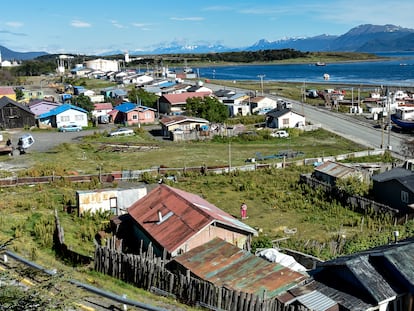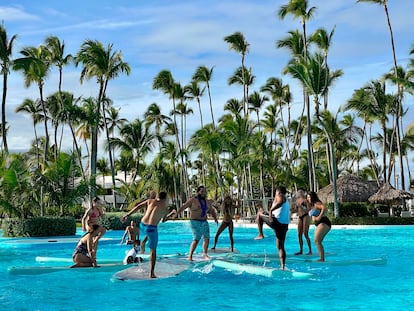How Easter Island has changed since pandemic
Following one of the longest quarantines in the world, the authorities of the island are considering curbing the pre-pandemic tourist turmoil
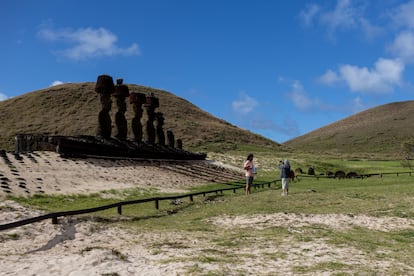

As the first commercial plane descended on Chile’s Easter Island on August 4, after 872 days of closure due to the pandemic, the passengers crowded the windows to photograph it as if they were facing some rare species in the middle of a safari. It was understandable: in addition to the uniqueness of being one of the most isolated inhabited corners of the planet, as well as its enigmatic sculptures carved in volcanic stone, for two and a half years the pandemic had completely cut off tourism to the island, its economic mainstay. Its inhabitants were isolated in the middle of the Pacific Ocean. It was a bubble of 7,000 people that was only punctured at the beginning of this month. And on that island, which is also known as Rapa Nui (the navel of the world), the first visitors discovered that something had changed.
After the island closed, the tourists disappeared and, with them, the source of income for 75% of the population. Practically nobody cultivated the land anymore, and there was a significant shortage of products. “Tourism had us dazzled. People thought: tourism brings money, and money buys eggs. What do I want chickens for?” explains Julio Hotus, general secretary of the Council of Elders.
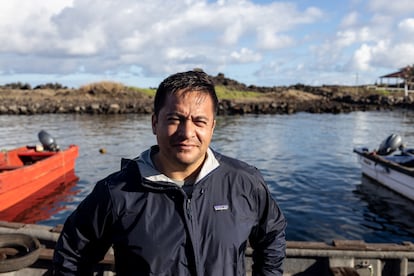
The people turned to the sea for food. A deep blue sea in which you can easily see 30 meters away. Divers claim that once you submerge into the waters of Easter Island, the rest of the world seems black and white. People also began to grow their own food. Today, there are 1,200 urban gardens thanks to the help of the municipality. “We reconnected with each other. Went back to family events. To cooking curanto [a dish with spiritual dimensions], to fish, to dive, to walk around the island. We went back to the places that had been occupied by tourists,” says Uko Tongariki Tuki, the municipality’s tourism chief.
Two weekly flights
In August, LATAM airlines resumed the route with two weekly flights. The plan is to gradually add more. Before the pandemic, there were 10, plus the charter flights and cruise ships. Easter Island, with a surface of 164 square kilometers, used to receive 156,000 yearly visitors, which translated into $120 million for its economy.
Tourism has also been a launch pad for the newer generations. Thanks to this solid source of income, many young people have been able to study in universities on the mainland and travel. “In order to achieve a balance, we are working with the different players in the industry. In these meetings we ask ourselves if 14 weekly flights are necessary, or if opening a new hotel is responsible,” explains Uko.
Mayor Pedro Edmunds is aware that the new phase must be based on sustainability – the optimization of water and energy, but also of human resources. “We were wrong, we were going in the wrong direction and the pandemic made us realize that,” he says. “We came to the conclusion that tourism had blinded us. We were being a bit hypocritical by telling what the island was about without actually living it ourselves.”
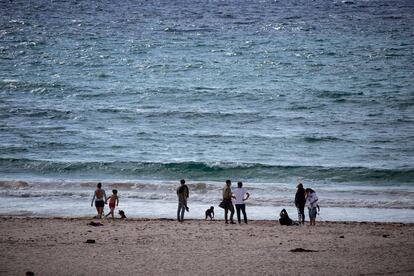
A “tourist” identity
For Hotus, a Rapa Nui councilor, the island is divided into two types of people: those from a more popular neighborhood, who are more rooted in traditions, and those who have more contact with the outsiders and the tourist business community. “Tourism is shaping the identity of the Rapanui people. Tourism tells us how we should function. We are not a tourist proposal; we are an answer,” he says.
The problems that the people of Easter Island face, such as violence and the consumption of alcohol or drugs – points out psychologist Domingo Izquierdo – have a lot to do with an identity crisis, a loss of roots. “These are the consequences of a process that has ended up building a tourist identity above its ancestral essence,” says Izquierdo.
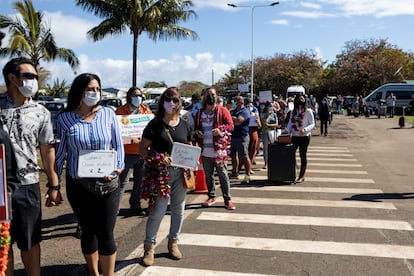
Tourism has been a springboard for new generations. Thanks to this solid source of income, many young people have been able to educate themselves in universities on the mainland and travel. “To achieve balance, we are working with the different players in the industry. In these meetings, we ask ourselves if 14 flights a week are necessary or if it is responsible to open a new hotel”, describes Uko. The mayor is clear that the new stage must be based on sustainability. The optimization of water and energy, but also of human resources.
During the pandemic, nearly 2,000 inhabitants left the island, most of the conti, as the islanders refer to Chileans living on the mainland. "Before we looked for solutions to our problems abroad, now we want to train and specialize our people," adds Edmunds.
The “tourist” identity
For Hotus, a Rapa Nui councilor, the island is divided into two types of people: those from a more popular neighborhood, who are more rooted in traditions, and those who have more contact with outsiders and the tourist business community. “It is so much that tourism is shaping the identity of the Rapanui people. Tourism tells us how we should function. We are not a tourist proposal, we are an answer,” he says over a fresh tuna lunch at the Topa Ra’a seaside restaurant, where waiters are eager to serve visitors again.
The problems faced by the people of Easter Island, such as violence and the consumption of alcohol or drugs, “have a lot to do with an identity crisis, a loss of roots,” says psychologist Domingo Izquierdo. “These are consequences of a process that has ended up building a tourist identity, above its ancestral essence,” says Izquierdo, who cares for patients through a municipal program in a house open to the people, where therapies can be developed under an avocado or with your feet in the sand.
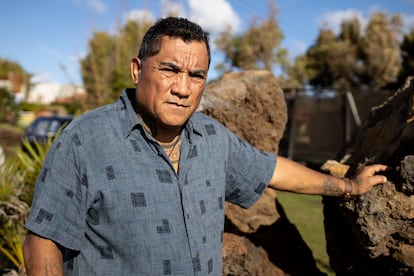
One of the great causes of the Council of Elders, which watches over the rights of the Rapanui people before the Chilean state, is the preservation of their language, which is of Polynesian origin. Nowadays, fewer and fewer young people learn it. In their own homes, they prioritize Spanish or English, because it is “more useful.” Only 10% of those under the age of 18 speak Rapanui, according to UNESCO.
Polynesian dances are one of the most sought-after tourist attractions. The energetic traditional dances can rekindle the spirit of the most exhausted traveler at the end of the day. Men and women, with painted and feathered bodies, move in such a way that it would seem that they have the drums inside their hips and a ukulele in their knees and wrists.
Maima Rapu is a teacher at the Kari Kari cultural ballet, the oldest on the island and the only academy that continued to teach during the pandemic. Earlier this month, the Kari Kari ballet was finally able to perform again in front of an audience. Among the spectators were some of the 258 people who arrived on the first commercial flight. Some of them were relatives of the islanders, parents who had not seen their children in more than a year and foreigners who had their ticket since 2020.
The Rapanui, eager to see new faces and to reactivate their economy after one of the longest quarantines in the world, have reopened their doors with the intention of changing their relationship with tourism. And those who know this 100% indigenous territory in depth, assure that nothing can be done against the intentions of the island.
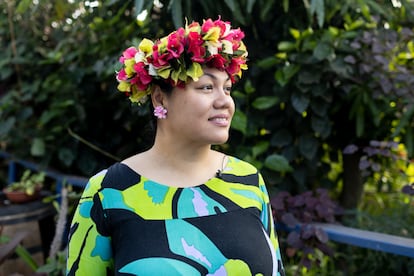
Maima Rapu, 42, is a teacher at the Kari Kari cultural ballet, the oldest on the island and the only academy that continued to teach during the pandemic. “For us, dance and percussion are a means to interest young people in picking up their language, which we also teach them, because you can’t really dance if you don’t understand what is being sung,” she explains.
Last Friday, the Kari Kari ballet was finally able to perform again in front of the public. Among the spectators were some of the 258 people who arrived on the first commercial flight. Among the passengers were relatives of the islanders, parents who had not seen their children in more than a year and foreigners who had the ticket since 2020. All were greeted with cheers and applause from a group that approached the Mataveri international airport, and with cheerful flower leis delivered by the reception team.
The Rapanui, eager to see new faces and revive their economy after one of the longest quarantines in the world, have reopened their doors with the intention of changing their relationship with tourism. And, those who know this indigenous community, say there is nothing that the island always achieves its goals.
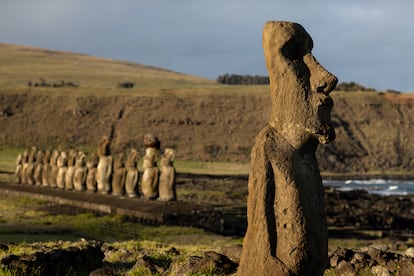
Tu suscripción se está usando en otro dispositivo
¿Quieres añadir otro usuario a tu suscripción?
Si continúas leyendo en este dispositivo, no se podrá leer en el otro.
FlechaTu suscripción se está usando en otro dispositivo y solo puedes acceder a EL PAÍS desde un dispositivo a la vez.
Si quieres compartir tu cuenta, cambia tu suscripción a la modalidad Premium, así podrás añadir otro usuario. Cada uno accederá con su propia cuenta de email, lo que os permitirá personalizar vuestra experiencia en EL PAÍS.
¿Tienes una suscripción de empresa? Accede aquí para contratar más cuentas.
En el caso de no saber quién está usando tu cuenta, te recomendamos cambiar tu contraseña aquí.
Si decides continuar compartiendo tu cuenta, este mensaje se mostrará en tu dispositivo y en el de la otra persona que está usando tu cuenta de forma indefinida, afectando a tu experiencia de lectura. Puedes consultar aquí los términos y condiciones de la suscripción digital.
More information
Últimas noticias
There is as much life left to discover on planet Earth as that which is already known
Dozens presumed dead, around 100 injured in fire at Swiss Alps bar during New Year’s celebration
Is porn for women different from conventional porn? We spoke to those who make it
Cartagena de Indias is sinking: What can the city do to mitigate it?
Most viewed
- Sinaloa Cartel war is taking its toll on Los Chapitos
- Reinhard Genzel, Nobel laureate in physics: ‘One-minute videos will never give you the truth’
- Oona Chaplin: ‘I told James Cameron that I was living in a treehouse and starting a permaculture project with a friend’
- David King, chemist: ‘There are scientists studying how to cool the planet; nobody should stop these experiments from happening’
- Why the price of coffee has skyrocketed: from Brazilian plantations to specialty coffee houses
